Clams and cockles in the Mekong Delta
By Peter Starr*Bivalve culture is a major source of income for many households in Ban Tre Province, Viet Nam
| Meretrix lyrata (Sowerby, 1851) |
|---|
| Family: Veneridae (venus clams) |
| English: Ben Tre clam, Lyrate hard clam, hard clam |
| Vietnamese: Ngheu Ben Tre |
| World Distribution: Western
Pacific from the Philippines to Thailand; north to Taiwan
and south to Indonesia |
| Mekong Distribution: Ben Tre, Soc Trang, Tien Giang, Tra Vinh |
| Feeding: Filter feeder, mainly organic detritus and phytoplankton |
| Size: Up to 40-50 mm long, 40-45 mm high and 30-35 mm wide |
| Habitats |
| Meretrix lyrata
lives in mud flats with sandy or muddy bottoms. The clams are either concentrated in big estuarine areas or scattered in small coastal sand dunes mixed with mud flats. The species can tolerate water salinity of 7-25 grams of salt per liter. |
| Life Cycle |
| Reproduction occurs between March and June, and is sometimes extended to October. Fast growth takes place in May and June, with slow growth occurring between October and May. |
| Culture |
| The culture of this species has developed in coastal alluvial grounds of Ben Tre, Soc Trang, Tien Giang and Tra Vinh provinces with yields of up to 50 tonnes/ha. Although the Research Institute for Aquaculture No. 2 has succeeded in artificial production of the clam seed, most of the seed is obtained from the wild. The harvest usually takes place in February and May. The clams are either gathered by hand or harvested with a hand rake attached to a net. Processed clams are an important export item for coastal provinces of the delta. |
| Sources: Fisheries Informatics Centre, FAO |
According to the Vietnamese Ministry of Agriculture and Rural Development, scientists have identified 800 species of mollusc in Viet Nam. Those of economic value are limited to 15 species of gastropods (snails and slugs) and 26 species of bivalves such as clams, cockles, mussels, scallops and oysters. Most live in marine waters, especially in central Viet Nam. But some bivalves are also found in estuarine tidal flats such as those of the Mekong Delta where they can tolerate water salinity as low as 7 grams of salt per litre (about one fifth the salinity of seawater).
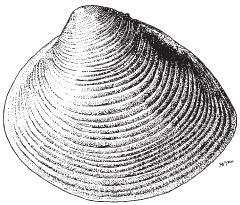
Exterior of left valve of Ben Tre
clam
Source: FAO
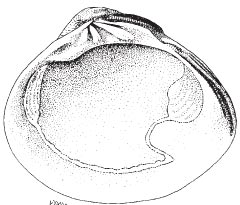
Interior of right valve of Ben Tre
clam
Source: FAO
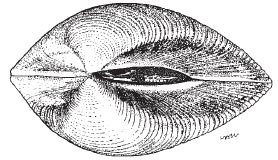
Dorsal view of both valves
Source: FAO
Such brackish waters are ideal habitats for two species from the venus clam family—the Ben Tre clam (Meretrix lyrata) and the Asiatic hard clam (Meretrix meretrix). The Ben Tre clam, also known as the lyrate hard clam, is distributed across the tropical waters of the Western Pacific as far north as Taiwan while the second species extends to East Africa and Japan. Another bivalve found in the Delta is the blood cockle (Anadara granosa), a species from the arc clam family with an even wider range extending from East Africa to Polynesia and as far south as Australia.

Interior of left valve of Asiatic
hard clam
Source: FAO

Exterior of right valve of Asiatic
hard clam
Source: FAO
| Meretrix meretrix (Linnaeus, 1758) |
|---|
| Family: Veneridae (venus clams) |
| English: Asiatic hard clam |
| Vietnamese: Ngao dau |
| World Distribution: Indo-West
Pacific from East Africa to the Philippines; north to Japan
and south to Indonesia |
| Mekong Distribution: Ben Tre, Tien Giang |
| Feeding: Filter feeder, mainly phytoplankton |
| Size: Up to 130 mm long, 110 mm high and 58 mm wide |
| Habitats |
| Meretrix meretrix lives at water depths of 1-2 m of water in tidal zones with sandy muddy bottoms. The clams bury themselves at depths of 3-4 cm and use a water-siphoning tube to get food from outside. The species tolerates temperatures of 20-30° and water salinity of 9-20 grams of salt per litre |
| Life Cycle |
| The species reproduces once or twice a year between April and October. The clams are fast growing with juveniles of 5mm capable of reaching 5-70mm in 10 months. |
| Culture |
| The culture of this species mainly involves collecting seeds from the wild and releasing them into net enclosures placed on tidal flats at depths of 1-3m. The practice has proven effective and stable, yielding up to 25 tonnes/ha. The three-month harvest periods are usually from April to June and from October to December. Harvesting usually involves dredging. The species is processed for export. |
| Sources: Fisheries Informatics Centre, FAO |
Viet Nam's overall mollusc production is estimated at 300,000-350,000 tonnes a year. Clam production is estimated at 50,000-60,000 tonnes while the production of blood cockles is estimated at 40,000-50,000 tonnes. In the Mekong Delta, production of these species is concentrated in five coastal provinces—mainly Ben Tre and Tien Giang but also Tra Vinh, Soc Trang anf Kien Giang.
Although scientists from government research institutes in Ho Chi Minh City and Nha Trang have produced artificial seed with varying degrees of success, the semi-natural system of culturing clams and cockles in the Delta still relies mainly on wild seed.
Ben Tre: coconuts, cocoa, clams and cockles
Ben Tre province, located about two hours south of Ho Chi Minh
City, is perhaps best known as the coconut capital of Viet Nam,
although it has recently attracted considerable attention for
major investment in cocoa plantations. Clams and blood cockles
are another important, and arguably more stable, source of income
for the province. With yields exceeding 16,000 tonnes, bivalves
accounted for almost 17 percent of its overall fisheries output
including marine fisheries in 2007 (see table
on page 32). Although yields were similar in 2008, that bivalve
share of fisheries production declined last year as catfish
production more than doubled. The 4,000 or so hectares set aside
for bivalve culture has, however, remained stable at about 10
percent of the area allocated for aquaculture in the province,
which is mostly devoted to marine shrimp farming and largely
concentrated in two coastal districts (see table
on page 33).
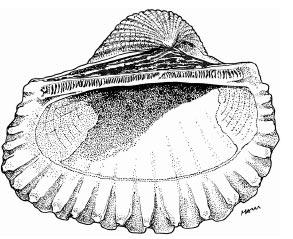
Interior of blood cockle
Source: FAO

Exterior of blood cockle
Source: FAO
| Anadara granosa (Linnaeus, 1758) |
|---|
| Family: Arcidae (arc clams) |
| English: Blood cockle |
| Vietnamese: So huyet |
| World Distribution: Indo-West
Pacific from East Africa to Polynesia; north to Japan and
south to Australia |
| Mekong Distribution: Ben Tre, Kien Giang |
| Feeding: Filter feeder, including zooplankton and organic detritus |
| Size: Up to 60 mm long, 50 mm high |
| Habitats |
| Anadara granosa
lives at water depths of 1-2 m of water in intertidal zones,
especially estuarine areas affected by fresh water. The
clams usually bury themselves in muddy bottoms and tolerate water salinity of 15-20 grams of salt per liter. |
| Life Cycle |
| Although the species can spawn all year round,
the main spawning period is from April to August. After
undergoing metamorphosis, the larvae moves to the bottom
when its eye point appears. |
| Culture |
| Blood cockles are cultured on tidal flats with yields of about 60 tonnes/ha. Seeds are usually collected from the wild, although Resarch Institute No. 3 has had initial results in producing artificial seed. The species is harvested throughout the year with the main season running from June to September. Blood cockles are harvested manually or by dredging. |
| Sources: Fisheries Informatics Centre, FAO |
One of those districts is Binh Dai, where the main channel of the Mekong flows into the South China Sea. About 20 kilometres from the mouth of the river is the coastal hamlet of Thai Loi 1, home to the Rang Dong Fisheries Cooperative established in 1997. The co-op, whose name means "sunrise" in Vietnamese, is the biggest in Ben Tre with 64 staff and more than 1,000 households from Thai Lai 1 and five neighbouring hamlets in Thoi Thuan commune.
With a dozen security posts along its perimeter, the Rang Dong Co-Op oversees 900 hectares of coastal mud flats—more than 20% of the area allocated to bivalve culture in Ben Tre and only 60% of the potential area that could be locally exploited. In this case, the species being cultured is the Ben Tre clam, an important export item that fetches about VND 18,000/kg ($1.03) locally and as much as VND 25,000/ kg ($1.43) in Ho Chi Minh City. According to locals, that compares with VND 1,500 to VND 2,000/kg a decade ago (which may help to explain why many Vietnamese city-dwellers complain they can no longer afford to eat this species).

Clam gatherers supplied this vessel
with about 15 tonnes of Ben Tre
clams during a single morning in February
Photo: Lem Chamnap
The culture of Ben Tre clams is said to date back to 1965. Today, the area set aside for culturing the clams in Thoi Thuan commune extends as much as 5km offshore at low tide. Access is usually restricted to co-op members with identity cards and the mud flats are policed by uniformed staff. Seed is collected from the mud flats between April and October and the harvest usually takes place in February and May. Both men and women take part in the harvest which involves gathering the clams either by hand or a hand rake attached to a net, known as cao ngheu tit in Vietnamese (a different type of rake called cao ngheu giong is used to collect juveniles). In late February, clam gatherers were being paid VND 40,000/20kg although each was limited to 60kg during each "shift" lasting about six hours. At that rate, a typical low-tide harvest of 15 tonnes for a single boat would require at least 250 people a shift. According to the co-op, the value of the clam harvest in 2008 was VND 48 billion.
Seeking certification
Binh Dai is not the only district in Ben Tre where this species
is cultured. It is also raised in Bat Tri and Thanh Phu, two
coastal districts further south, and the clam fishery in all
three districts is now in the final phase of an assessment by
the Marine Stewardship Council (MSC), a British-based global
certification and eco-labelling programme for sustainable seafood
production. In January, the MSC announced that the certification
body Moody Marine Ltd had proposed two peer reviewers for its
draft assessment of the Ben Tre clam fishery which evaluates
its compliance with MSC standards for sustainable and well-managed
fisheries.
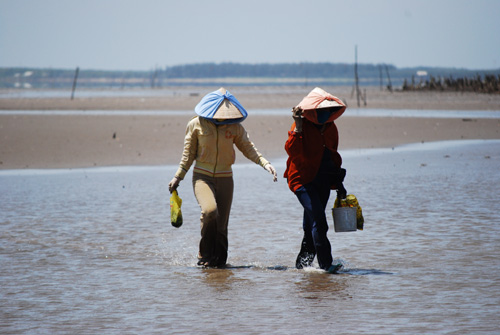
Members of the Rang Dong Fisheries
Cooperative returning home after a morning gathering
clams in Binh Dai district in Ben Tre province
Photo: Lem Chamnap
At the same time, the Ben Tre clam fishery is undergoing a parallel assessment using a pilot method developed by the MSC to assess small-scale datadeficient fisheries. In assessing the management of the fishery, the MSC has already noted the complementary roles of the the central government, which limits the area where clams can be harvested, and the provincial government, which controls minimum landing size and equipment used.

Clam gatherer returns her ID card
after a morning's work at
low tide
Photo: Lem Chamnap
The MSC was established to address the problem of overfishing and now covers more than 2,000 products worldwide. With offices on six continents, it is the only labelling program consistent with the code of the International Social and Environmental Accreditation Alliance (ISEAL) and FAO guidelines for fisheries cerification. The latter require certification and labelling schemes to include objective thirdparty assessments, transparent processes and standards based on the sustainability of target species, ecosystems and management practices. As of February, the programme had certified 41 certified fisheries of which only two were in Asia, both in Japan. Another 99 fisheries were being assessed including the Ben Tre clam fishery. The Vietnamese move to get the fishery certified dates back to 2005 when the then Vice Minister of Fisheries signed an agreement with the MSC to explore and encourage sustainable fishing practices. The agreement led to pilot projects to assess the Ben Tre clam fishery as well as an anchovy fishery on Phu Quoc, an island off the coast of Kien Giang province.
Among those who potentially stand to benefit from environmental certification are clam export processors such as Ben Tre Aquaproduct Import and Export Joint Stock Company (Aquatex Bentre) and Bentre Seafood Joint Stock Company (Beseaco). Listed on the Ho Chi Minh Stock Exchange at the end of 2006, Aquatex Bentre processes catfish and shrimp as well as clams with sales exceeding VND 400 billion ($23 million) in 2007.
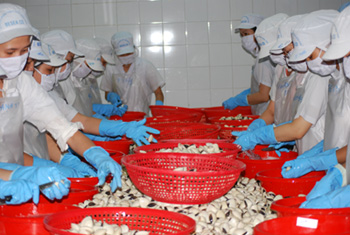
Beseaco workers sorting clams at the
Ben Tre processing plant.
Photo: Lem Chamnap
With most of its processing business concentrated on clams, Beseaco has been less exposed to the recent turmoil in the catfish market (see Catch and Culture, Vol 14, No 2). According to the company's Vice Director Bui Van Kinh, Ben Tre clams account for about 80 percent of the company's business with Asiatic hard clams making up the remaining 20 percent. That's poised to change, however, following the opening of a catfish processing plant in October. Beseaco mostly exports cooked frozen clams to European markets, notably Italy and Spain, and currently processes about 20 tonnes a day at its plant in Ben Tre town which employs 350 workers in two shifts. According to Mr Kinh, the company's sales came to about $5 million or VND 90 billion in 2008.
Bivalve production forecast to expand this
year
While figures for the value of clam production in Ben Tre are
not available, the provincial statistics office publishes annual
data which show a significant increase in the value of overall
fisheries production since 2000. According to preliminary figures,
the total value of fisheries output in Ban Tre was VND 4,225
billion in 2007, equivalent to about $240 million at today’s
exchange rate and more than twice the value in 2000 (see table
next page). During this period, the value of capture fisheries
was more or less stable at around VND 1,000 billion a year.
But the value of aquaculture production grew almost sixfold
to more than VND 3,000 billion in 2007. As a result, the structure
of fisheries production has changed dramatically since 2000
when capture fisheries accounted for two thirds of the overall
value of fisheries output. Seven years later, the situation
was reversed with capture fisheries representing 26% of the
value while aquaculture accounted for 72% (the other 2% came
from fisheries services).

Packaged clams ready for freezing
at the Beseaco plant
Photo: Lem Chamnap
Fisheries remains one of the three main contributors to the Ben Tre economy along with manufacturing and the cultivation of various crops including rice and fruit as well as coconuts and cocoa. According to preliminary figures for 2007, fisheries accounted for 18% of gross provincial product, making it the second most valuable economic activity after manufacturing (see chart on opposite page). In terms of jobs, however, fisheries ranked second only to agriculture, employing almost 61,000 people—almost 10% of the local workforce—compared to only 44,000 in manufacturing. At the same time, fisheries employed about the same number of people as the the wholesale and retail sectors and more than the hospitality, construction and education sectors combined.
In terms of volume, the Department of Fisheries in Ben Tre expects overall fisheries production to fall 12% this year after surging 38% from a year earlier to more than 239,000 tonnes in 2008. The expected decline reflects a lower forecast for the production of catfish, expected to fall about 30% from last year's levels. Marine shrimp production is also forecast to decline while production from capture fisheries and farmed freshwater prawns is expected to be almost unchanged.
On the other hand, bivalve culture is forecast to expand this year. After contracting slightly in 2008, the production of clams and cockles is expected to grow 8% to 18,000 tonnes in 2009. Based on recent prices for Ben Tre clams, that would be worth about VND 320 billion or almost $20 million a year to the local economy including almost $2 million for the people who harvest the clams. For the harvesters alone, that equates to average annual income of about $400 for each household in the Rang Dong Co-Op without taking into account additional income from collecting seed and value-added services such as storage, transport and wholesale trading.
Ben Tre Fisheries Production
Tonnes| Species | 2007 | 2008 | 2009¹ |
|---|---|---|---|
| Marine shrimp | 23,717 | 21,265 | 20,000 |
| Freshwater prawn | 1,449 | 1,696 | 1,700 |
| Fish | 56,950 | 118,508 | 88,500 |
| of which Sutchi river catfish² | (40,963) | (100,025) | (70,000) |
| Bivalves | 16,694 | 16,620 | 18,000 |
| Other aquatic species | 40 | 906 | 1,000 |
| Total culture | 98,850 | 158,995 | 129,200 |
| Fish | 55,788 | 63,588 | 63,500 |
| Shrimp | 4,262 | 1,478 | 1,500 |
| Squid and other species | 15,061 | 15,075 | 15,000 |
| Total catch | 75,066 | 80,141 | 80,000 |
| Total production | 173,916 | 239,136 | 209,200 |
¹ Projected
² Pangasianodon hypophthalmus
Source: Department of Fisheries, Ben Tre province
Aquaculture Area in Ben Tre
Hectares| Species | 2007 | 2008 | 2009¹ |
|---|---|---|---|
| Marine shrimp | 31,707 | 31,462 | 31,400 |
| of which high or semi-high density | (5,842) | (5,597) | (5,500) |
| Freshwater prawn | 2,245 | 2,261 | 2,300 |
| Fish | 3,607 | 3,986 | 3,900 |
| of which species with no scales | (468) | (650) | (550) |
| Bivalves | 4,114 | 4,210 | 4,200 |
| Other species | 178 | 187 | 200 |
| Total Area | 41,851 | 42,106 | 42,000 |
¹ Projected
Source: Department of Fisheries, Ben Tre province
In a country with a GDP of about $1,000 a head, the economic benefits of the Ben Tre clam fishery are easy to appreciate, especially when prices are 10 times higher than a decade ago. Whether clams are as well placed as catfish to weather the global economic downturn remains to be seen.
* Mr Starr is the editor of Catch and Culture
Fisheries Contribution to Economy ...
Gross provincial output, 2007 (preliminary)| Economic activity | % |
|---|---|
| Manufacturing | 20.7 |
| Fisheries | 18.0 |
| Cultivation | 16.8 |
| Construction | 8.4 |
| Livestock | 7.9 |
| Wholesale and retail trade | 5.9 |
| Financial intermediation | 4.2 |
| Other | 18.1 |
| Total | 100.0 |
Source: Ben Tre Statistical Yearbook, 2007
... and Employment
Employment by type of activity, 2007 (preliminary)| Economic activity | Persons employed |
|---|---|
| Agriculture | 432,210 |
| Fisheries | 60,914 |
| Wholesale and retail trade | 60,872 |
| Manufacturing | 44,187 |
| Hotels and restaurants | 17,637 |
| Construction | 17,441 |
| Education and training | 15,540 |
| Other | 46,049 |
| Total | 694,852 |
Source: Ben Tre Statistical Yearbook, 2007
Value of Fisheries to Ben Tre
Current prices in billions of dong (figures rounded)| Activity | 2000 | 2001 | 2002 | 2003 | 2004 | 2005 | 2006 | 2007 |
|---|---|---|---|---|---|---|---|---|
| Culture | 555 | 824 | 1,043 | 1,230 | 1,890 | 2,135 | 2,618 | 3,048 |
| Catch | 1,064 | 917 | 886 | 855 | 925 | 994 | 1,060 | 1,138 |
| Services | Neg | Neg | Neg | 12 | 13 | 33 | 68 | 39 |
| Total | 1,620 | 1,742 | 1,930 | 2,096 | 2,828 | 3,163 | 3,747 | 4,225 |
Source: Ben Tre Statistical Yearbook, 2007

Choose a newsletter: